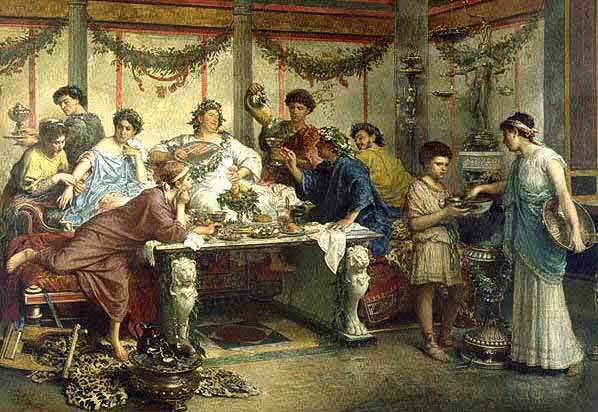I have been living in Rome for about 20 years, but I’m from Naples. My grandfather was a wine producer and trader in the Vesuvio area.
After working for many years in a bank I have decided to give it up and concentrate on something I really enjoy; so I entered the wine world and attended a sommelier course. The desire of deepening my knowledge of wine, especially the Italian ones, has brought me to follow many lessons and tastings.
I’d like to start our route through wine’s culture from a wine I particularly love, Aglianico; it reminds me my childhood, when I drank it during the summer with my uncle with pieces of peaches.
Ancient Romans Wine
In ancient Rome, the preferred wines came from Campania, from the plain area between sea and mountain, crossed by the Volturno River. Because of its unique climate it was called Campania Felix.
 At that time, the most famous wine was the Falernum (today known as Falerno) produced at the slopes of the Massico mount, in the province of Caserta, with Aglianico and Falanghina grapes born from very ancient vines brought here by the Greeks 3,000 years ago. Falernum red wine is from the Aglianico vine, Falernum white wine is from Falanghina vine.
At that time, the most famous wine was the Falernum (today known as Falerno) produced at the slopes of the Massico mount, in the province of Caserta, with Aglianico and Falanghina grapes born from very ancient vines brought here by the Greeks 3,000 years ago. Falernum red wine is from the Aglianico vine, Falernum white wine is from Falanghina vine.
Falernum is the Emperors’ wine as described by the Latin poets. It was so famous that the Roman ships delivered it everywhere in the known world.
After the Romans, the Popes have been fond of this wine.
These special vines risked extinction at the beginning of the 20th century owing to a parasite that destroyed its roots. Only some vines succeeded in surviving in the provinces of Caserta, Avellino and Benevento.
Nowadays, many producers in these areas, after working long on their vines, have taken back Falerno to its ancient prestige. We can also thank the professionalism of great oenologists.
Falerno rebirth began about 50 years ago due to the work of ‘oenological archaeology’ lead by a small company based on the Massico Mount hills: Azienda Villa Matilde (Strada Statale Domiziana, Localit’ Cellole ‘ Caserta). After long research, the farm managed to single out the grapes used by the Romans, discovering again the ancient ‘Aglianico’ vine.
– Falerno del Massico (Vigna Camarato) Villa Matilde: D.O.C. red wine from Aglianico grapes, with intense nose of flowers like violet, plum, sour black cherry and berry fruits, extremely long rich palate. Excellent wine with very good tannin, it can stand a long ageing.
Perfect with lamb and baked potatoes, roasted meat and hot cheeses.
– Falerno del Massico (Vigna Caracci) Villa Matilde: D.O.C. white wine from Falanghina grapes. The nose is of white and yellow flowers like broom, apple and exotic friuts. The palate is an ensemble of all these flavours. It is perfect with spaghetti with clams, baked fish, pasta and beans, pork meats.
Another farm in this area has contributed to the salvage of another precious vine: Aglianico; it is the Azienda Mastrobernardino (localit’ Atripalda ‘ Avellino) that produces an excellent wine called Tauras’ (one of the most important Italian red wines). Its name derives from Taurasia, an ancient town near Avellino, quoted by Tito Livio for its very good vines.
– Tauras’ (Radici) Mastrobernardino: D.O.C.G. red wine, from Aglianico grapes. The nose is of rose and violet, red mature fruits and spices. The palate is complex and austere with velvet tannin. Powerful wine ideal for a very long ageing. Very good with filled pastas, baked meats, game, truffles and seasoned cheeses.
The Aglianico grape has a great personality and an ancient flavour unique to our country. Its heritage is of Southern Italy viticulture, it is a continuously evolving vine that has already reached a very high level of quality that will characterise the future of the Italian wines.
Ancient Romans were right, their Vinum Falernum survived history.
by Angela D’Avino
The Rome Central – Italy in the world editorial staff consists of freelance editors, journalists, photographers, filmmakers, doctors, writers, video-makers, supporters, poets, writers, actors, singers and many friends.
RomeCentral is a Magazine completely no-profit , whoever writes in this magazine does his job without any commercial pressure.
NB: No people in Rome Central, from managers to employees etc .., receive any type of compensation.
The love for the free journalism repays all our efforts.


Excellent!! Honest reviews for Ancient Roman wines, it is very nice to know the reality of the wine you like the most. As I am a wine lover, I love to read the blog like this so please keep Sharing! I also found one youtube channel #WineTerroir where Robert Vernick also shares true reviews on the variety of wines.